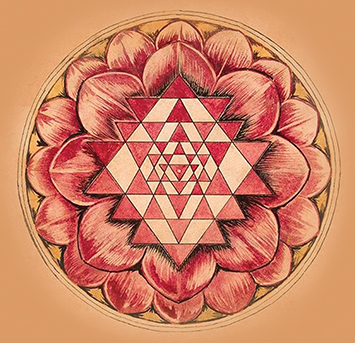
Sri Vidya Upasana & Vedanta 
As a sadhaka progresses in one's spiritual journey, the journey inward leads to higher understanding and realisation, known as Gnana Yoga.
Having understood the deeper meanings and other secrets in the Lalitha Sahasranama, the sadhaka is guided through higher Vedantic knowledge and practices in the journey from Karma Yoga to Gnana Yoga.
Summary of session 1
The below points were explained:
- The significance and reason for the course topic
- The meaning of Upasana
- The importance of Karmas
- Purification of the 3H: Head, Hand & Heart
- Saguna & Nirguna Upasana
- The aim & content of the course
Summary of session 2
- Sukha & Dukha; Karmaphala
- The 3 kinds of Karma; Sanchita, Agamya & Prarabdha
- The 3 Shareeras; Sthula, Sukshma & Karana
- Moksha; Discovery of the Self
- The impermanent experiences of Swarga & Naraka
- Vachyartha & Lakshyartha
- Apara Vidya; Saguna Upasana; Sri Vidya & Maha Vidya
- Para Vidya; Nirguna Upasana; Atma Vidya
- Pancha Pramanas; Pratyaksha, Anumana, Udharana, Arthapathi & Anuphalapthi
- Secret of the universe and meaning of the Tryakshari Mantra
Introduction to Atma Bodha; Knowledge of the self
Summary of session 3
The below points were explained:
- Vedas; a way of living
- Nithya Karma, Naimittika Karma & the 4 Ashrama Dharmas
- Significance of Agnihotra
- Vachyartha & Lakshyartha
- What is Upasana?
- 32 Brahma Vidyas as per Shastra
- The two kinds of meditation; Concentration & Contemplation Meditation
- Meaning of Guru Paduka Mantra
- Meaning of Sri Vidya
Participants were initiated & blessed, to begin the Tryakshari Sadhana
Summary of session 4
The below points were explained:
- The completeness of Sri Vidya Upasana
- Meaning of 'Gam' beejakshara
- Understanding 'Mauna'
- Going inward
- Atma Bodha - 1, 2, 3.
- Participants were initiated & blessed, to begin Ganapati Beejakshara
Summary of session 5
The below points were explained:
Progressing from Dvaita to Advaita Bhava
- Karmas in each Ashrama
- Significance of Agni & Gau in the Vedic culture
- Karma & Karma Phala
- Worshipping Kubera, the right way
- What is Upasana
- Introduction to Varivasya Rahasyam
- Varivasya Rahasyam; 1
- Atmabodha; 1, 2, 3, 4
- Sadhana Chatushtayam
- Shatkasampathi
Summary of session 6
- Sri Vidya Upasana, the stepping stone towards Vedanta realization
- Swamiji's journey from Upasana to Vedanta
- Bhakti, Karma & Raja Yoga; Ahamkara is the base
- Gnana Yoga; understanding Ahamkara
- Overcoming Avidya - the Samsara Karanam.
- Gnanam - Moksha Karanam.
- The role of a Guru & attitude of a Sadhaka
- Secret of Sri Vidya in Vedas; References of Varivasya Rahasyam; Prathama Amsha, Shloka 8
- The greatness of Sri Vidya
- Advaita Vedanta Purva Samayachara Sri Vidya Margam
- Sri Chakra Laghu Navavarna Puja Started.
- Navavarnas in Sri Yantra
- Mandira Pravesha was taught.
Summary of session 7
The below points were explained:
- Guru Sishya Sambandha
- The beauty and depth of the Vedic culture
- Shrishti Prakarana
- Om Unmesha Nimishotpanna Bipanna Bhuvanavalyai Namaha (Nama 281)
- Eternity of Veda Shabdas
- Maheshwarani Sutrani
- Vedas, remedy for sorrow
- The blessing of a human life
- Understanding Ishwara is the aim and not just believing in Ishwara
- Tat Tvam Asi
- Importance of Nithya Karma Anushtanam
- Vedanta: View of life
- Dharma: Way of life
- Bhakti Yoga, Karma Yoga, Dhyana Yoga
- Understanding 'Dwaitam Bhayam Advaitam Nirbhayam'
Summary of session 8
The below points were explained:
- Prarthana for Loka Kshema
- Understanding that the individual is not different from the universe
- The healing power of Tryakshari mantra
- Understanding that everything there is, is Ishwara
- Why one must respect & workship oneself; Physical body is the temple where Ishwara & Devi reside
- Om Sukharadhyayai Namaha (Nama 681)
- Evolving from being a Bhakta to an Upasaka
- Meaning & significance of Alambanam
- The aim of Upasana: Aham Shudha Chaitanyam Asmi
- The journey towards realizing Aham Brahmasmi
- Sri Chakra Laghu Navavarna Puja:
- Mayashakti: Avarna & Vikshepa Shakti
Nava Avarna:
Summary of Session 9:
The below points were explained:
- Journey of Sri Bhasuranadanatha from Maharashtra to Tamilnadu & in writing the 3 sacred texts (Sethubandhanam, Vari Vasya Rahsayam & Soubhagya Bhaskaram)
- The great blessing of the treasure being taught to the sadhakas
- The value of the tradition & evolution from Karma kanda (Preyas) to Gnana kanda (Shreyas)
- The significance of Daivam & Vidihi
- Importance of 'Understanding'
- Vicious cycle of the lifestyle based on consumerism
- Dharma: the bedrock of human life
- Depth of the vedic tradition and reverence for all that there is
- Right understanding of Spirituality
- Experiencing & overcoming duality with selfless Ishwara bhakti
- Transition from Saguna Upasana to Nirguna Upasana in Sri Vidya Upasana
- The form of Lalithambika, signifying the Gnana marg<
Summary of session 16:
The below points were explained:
- Understanding Sri Yantra & its existence
- The source of one's own thoughts
- Dhyanam; enables one to become eligible for realization of the self
- Significance of the depth & power of Sri Vidya Dhyana
- Existence, is beyond space & time and preceeds all
- Nature of the mind (Sankalpa & Vikalpa)
- Knowledge removes ignorance
____
Atma Bodha;
- Shloka 5
____
Lesson 5;
- Mandira Archana
The below points were explained:
9 kundalini chakras are compared with Nava Avarnas of Sriyantra.
1: Trilokyamohana Cakra - Muladhara
2: Sarvasaparipuraka Cakra - Swadishtana
3: Sarvasamkshobhana Cakra - Manipuaraka
4: Sarvasaubhagyadayaka Cakra - Anahata
5: Sarvarthasadhaka Cakra - Vishuddhi
6: Sarva Rakshakara Cakra - Ajna
7: Sarvarogaharaka Cakra - Gurupeetam
8: Sarvasiddhiprada Cakra - Gayatri Peetam
9: Sarvanandamaya Cakra - Srividya Peetam
10th Center: The truth indicated by Sriyantra is Aham - Brahman
Participants were advised of the launch of Dayalaya Pathashala website (dayalayapathashala.org) and the option to post questions in video that will be answered.

Other Courses




